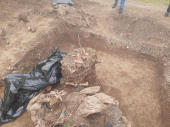Azerbaijan seeks decisive int'l action over Armenia's war crimes

By Sabina Mammadli/Vugar Khalilov
Human Rights Commissioner Sabina Aliyeva carried out a fact-finding mission in Azerbaijan's liberated lands to investigate Armenia-committed destructions of cemeteries during the 30-year occupation, the ombudsman's office has reported.
Justice for grave crimes
Sabina Aliyeva's report is based on the relevant evidence and materials obtained during the mission, and it covers the desecration of graves and the dead, as well as tombstone looting, landmines, and other visual incidents among people visiting graves.
The commissioner urges international organizations to take decisive action to bring Armenia to justice for grave violations of international law, including international humanitarian law and war crimes.
The report was distributed to international organizations, foreign ombudsmen, and other international organizations involved in human rights protection and promotion.
The human rights commissioner continues to inform the international community about Armenia's war crimes committed during the first and second Karabakh wars, as well as violations of international law and international humanitarian law.
During Armenia's three-decade occupation, some 900 cemeteries with over a million graves were decimated. Azerbaijani gravestones were even used to build stairs to Armenian homes. Car plates of killed and displaced Azerbaijanis were used to decorate public restrooms. Overall, during 30 years of occupation 927 libraries with 4.6 million books, 700 historical monuments and 22 museums with 100,000 exhibits were looted and destroyed by Armenia. Armenia looted and erased more heritage than ISIS terrorists did in Iraq and Syria. It is the worst cultural genocide of the 21st century.
To erase all traces of Azerbaijani culture and history Armenia systematically destroyed cultural and historical monuments. Out of 67 mosques, 65 were desecrated and destroyed. Many mosques were turned into pigsties and cowsheds like the Juma Mosque of Agdam (1870), Zangilan Mosque (17th century) or Marmar Mosque (18th century) in Gubadli.
Ethnic cleasing
Earlier, Azerbaijan’s ombudsman office also urged the international community to hold Armenia accountable for the mass ethnic cleansing and genocide that it committed against Azerbaijanis.
On March 3, the office made a statement in connection with the mass grave that was discovered in Edilli village of Azerbaijan’s Khojavand region.
The statement emphasized that the mass graves discovered as these areas were cleared of mines once again prove Armenia's policy of ethnic cleansing and genocide against Azerbaijanis, as well as war crimes committed against civilians. All these facts are the basis for bringing Armenia to international legal responsibility.
The statement recalled that Azerbaijanis captured and held hostage by Armenia during the first Karabakh war were brutally tortured to death, and then their remains were buried en masse.
It added that another mass grave was discovered in Khojavand’s Edilli village on the basis of testimonies and materials collected by the Azerbaijani Working Group of the State Commission on Captives, Missing and Hostages.
According to the statement, the remains of 15-20 Azerbaijani civilians killed during the occupation by the Armenian armed forces were buried at a depth of three meters, and there are other mass graves in the village as well.
The ombudsman office stressed that all these facts testify to Armenia’s gross violation of international law, as well as international humanitarian law, including the 1949 Geneva Conventions for the Protection of Victims of War, in particular the Convention for the Protection of Civilian Persons in Time of War and its Additional Protocol I of 1977.
It was underlined that there are many mass and individual graves in Azerbaijan’s liberated lands such as Khojavand, Kalbajar, Aghdam and Fizuli regions, as well as around the Shusha city.
On February 24, Azerbaijan discovered a mass grave in its liberated Kojavand region’s Edilli village.
Prior to the Khojaly genocide, Armenians committed the worst tragedy in the Khojavand region. The Garadaghli genocide was a stain on humanity, and terrible crimes were committed in the villages of Akhullu, Tug, Salaketin, and Edilli at the end of the twentieth century. The tragic days in Khojavand's villages started in 1988 when the Armenian separatist movement in Nagorno-Karabakh began.
Garadaghli, Akhullu, Tug, Salaketin, and Edilli fought valiantly against the Armenian invaders for several years. During those years, hundreds of villagers were killed in unequal battles with Armenian armed forces.
Azerbaijan and Armenia resumed the second war after that latter started firing at Azerbaijani civilians and military positions starting September 27, 2020. The war ended on November 10 with the signing of a trilateral ceasefire deal by the Azerbaijani, Russian and Armenian leaders.
The Azerbaijani army declared a victory against the Armenian troops. The signed agreement obliged Armenia to withdraw its troops from the Azerbaijani lands that it has occupied since the early 1990s.
In the war unleashed by Armenia, Azerbaijan's Ganja, Barda, Yevlakh, Beylagan, Tartar, Gabala, Goranboy, Aghjabadi, Khizi and other cities and regions, fairly far from the war zone, came under Armenia's missile and artillery fire.
International human rights watchdogs Amnesty International and Human Rights Watch verified the use of banned cluster bombs and missiles by Armenia in its attacks against Azerbaijani cities.
As a result, 100 Azerbaijani civilians were killed, including 12 children and 27 women. As many as 454 people were injured, including 35 children. Some 181 children lost one parent, five children lost both parents, one family died. In total, 12,292 residential and non-residential buildings and 288 vehicles were damaged.
--
Follow us on Twitter @AzerNewsAz
Here we are to serve you with news right now. It does not cost much, but worth your attention.
Choose to support open, independent, quality journalism and subscribe on a monthly basis.
By subscribing to our online newspaper, you can have full digital access to all news, analysis, and much more.
You can also follow AzerNEWS on Twitter @AzerNewsAz or Facebook @AzerNewsNewspaper
Thank you!



